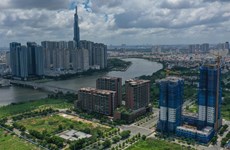Vietnam restructures rubber industry
The increasing global rubber demand in recent years has encouraged
Vietnam, the fifth biggest natural rubber producer in the world in 2012,
to restructure the industry to increase export value and
improve value chain . Report by the Vietnam Economic News.
Vietnam Rubber Group General Director Tran Ngoc Thuan said that to
restructure the industry, implementing mergers and acquisitions
(M&A) deals with small companies, associating with major brands,
reducing crude production and diversifying products to improve
added-value and ensure sustainable development were needed.
The increasing global rubber demand in recent years has encouraged
Vietnam, the fifth biggest natural rubber producer in the world in 2012,
to restructure the industry to increase export value and
improve value chain . Report by the Vietnam Economic News.
Vietnam Rubber Group General Director Tran Ngoc Thuan said that to restructure the industry, implementing mergers and acquisitions (M&A) deals with small companies, associating with major brands, reducing crude production and diversifying products to improve added-value and ensure sustainable development were needed.
Thuan also said that the group agreed with the restructuring project of the Ministry of Agriculture and Rural Development. However, in terms of the cultivation sector, the ministry must have appropriate views.
The cultivation sector currently accounts for 72 percent of the GDP of the agricultural sector. Therefore, it needs to confirm the role of businesses involved, especially in the fields of processing and creating a brand, building added-value chain and improving international competitiveness. It is difficult to maintain growth, increase income, eliminate food shortage and reduce poverty for rural households throughout the country when lacking the role of businesses.
In terms of competitive capacity of the rubber industry, Thuan said that Vietnamese rubber stood at top five in terms of area and top five in terms of exports. In addition, rubber production in Vietnam reached 1.75 tonnes of latex per hectare. Management and technology have basically met practical requirements.
High dependence on the Chinese market with 60 percent of exports to this market remains a weakness of Vietnam’s rubber industry. Therefore, promoting the exploitation and expanding the market are needed in the restructuring project.
The government assigned the Vietnam Rubber Group to develop 500,000 hectares of the tree by 2015. However, this goal seems infeasible in the context of current economic difficulties, and needs to be adjusted. The group’s point of view is to improve the quality of varieties, production and added-value chain.
To improve value chain for the industry, implementing M&A deals with small companies and linking to major brands to be able to produce competitive products are needed. In addition, the rubber industry should focus on constructing industrial infrastructure and manufacturing tire.
The group will focus on producing Medium-density fiberboard (MDF) in Quang Tri, Binh Phuoc and Kien Giang provinces. Moreover, research to expand business and production activities in the central region is necessary. The group strives to account for 50 percent of MDF output providing to the domestic market by 2015 and produces wooden boards and bars to diversity products.
Vietnam’s rubber industry strives to reach sales of 150 million VND (7,100 USD) per hectares. To build a brand for Vietnamese rubber, the group has successfully registered “caosuvietnam” brand name in some major markets.
According to Thuan, closely managing available rubber area is also an important point in the restructuring project, helping ensuring the quality of varieties and production.
The industry’s restructuring project only mentioned rubber areas in southeastern region and the Central Highlands. Therefore, Thuan proposed to add the south-central coast, the north-central coast and northern mountainous provinces into the list, adding that the establishment of a management agency on rubber is needed.
Vietnam Rubber Group General Director Tran Ngoc Thuan said that to restructure the industry, implementing mergers and acquisitions (M&A) deals with small companies, associating with major brands, reducing crude production and diversifying products to improve added-value and ensure sustainable development were needed.
Thuan also said that the group agreed with the restructuring project of the Ministry of Agriculture and Rural Development. However, in terms of the cultivation sector, the ministry must have appropriate views.
The cultivation sector currently accounts for 72 percent of the GDP of the agricultural sector. Therefore, it needs to confirm the role of businesses involved, especially in the fields of processing and creating a brand, building added-value chain and improving international competitiveness. It is difficult to maintain growth, increase income, eliminate food shortage and reduce poverty for rural households throughout the country when lacking the role of businesses.
In terms of competitive capacity of the rubber industry, Thuan said that Vietnamese rubber stood at top five in terms of area and top five in terms of exports. In addition, rubber production in Vietnam reached 1.75 tonnes of latex per hectare. Management and technology have basically met practical requirements.
High dependence on the Chinese market with 60 percent of exports to this market remains a weakness of Vietnam’s rubber industry. Therefore, promoting the exploitation and expanding the market are needed in the restructuring project.
The government assigned the Vietnam Rubber Group to develop 500,000 hectares of the tree by 2015. However, this goal seems infeasible in the context of current economic difficulties, and needs to be adjusted. The group’s point of view is to improve the quality of varieties, production and added-value chain.
To improve value chain for the industry, implementing M&A deals with small companies and linking to major brands to be able to produce competitive products are needed. In addition, the rubber industry should focus on constructing industrial infrastructure and manufacturing tire.
The group will focus on producing Medium-density fiberboard (MDF) in Quang Tri, Binh Phuoc and Kien Giang provinces. Moreover, research to expand business and production activities in the central region is necessary. The group strives to account for 50 percent of MDF output providing to the domestic market by 2015 and produces wooden boards and bars to diversity products.
Vietnam’s rubber industry strives to reach sales of 150 million VND (7,100 USD) per hectares. To build a brand for Vietnamese rubber, the group has successfully registered “caosuvietnam” brand name in some major markets.
According to Thuan, closely managing available rubber area is also an important point in the restructuring project, helping ensuring the quality of varieties and production.
The industry’s restructuring project only mentioned rubber areas in southeastern region and the Central Highlands. Therefore, Thuan proposed to add the south-central coast, the north-central coast and northern mountainous provinces into the list, adding that the establishment of a management agency on rubber is needed.












